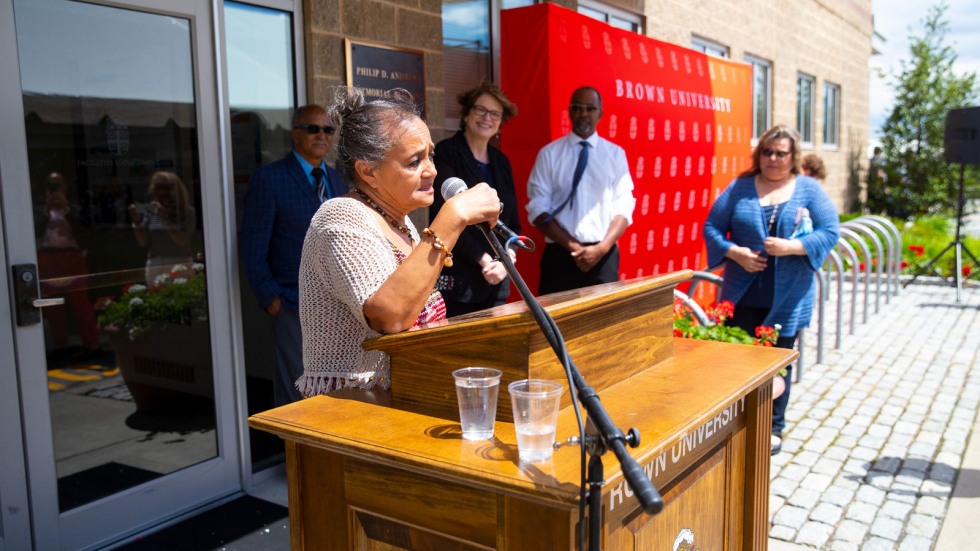PROVIDENCE, R.I. [Brown University] — For more than a decade, a plaque at the entrance to the Plant Operations department at Brown welcomed visitors to the Philip D. Andrews Memorial Building.
When the Olive Street building was demolished in 2001 to make way for the Sidney E. Frank Hall for Life Sciences, University staff carefully wrapped the plaque in butcher paper and painter’s tape, hoping they might display it elsewhere someday.
Nearly 20 years later — on Friday, June 14, 2019 — that “someday” finally came.
“Only one building has been dedicated to a member of the staff at Brown, and that [staff member] is Philip D. Andrews,” said Michael Guglielmo Jr., vice president for facilities management at Brown, at a gathering Friday. “Today, we will recognize him again.”
Guglielmo joined President Christina Paxson, Fellow Craig Barton from the Brown Corporation, members of Andrews’ family and hundreds of University employees on a sunny, gusty afternoon to dedicate and rename Brown’s current Facilities Management Building at 295 Lloyd Ave. to the longtime custodian and manager. Andrews was known by many on campus for his relentlessly positive attitude, innovative ideas and dedication to the institution, attendees said.
“Phil Andrews was emblematic of everything that we love about the people who work here,” Paxson said. “He gave Brown a lifetime of hard work and devotion, and clearly he had become a beloved member of his community and a beloved colleague to so many people… This building will always stand to honor that legacy.”
Though few current Brown employees had occasion to meet the late Philip D. Andrews, his story is familiar to many in Facilities Management — the successor department to Plant Operations — and elsewhere around campus. Andrews was hired by the University as a custodian in 1947 and spent his early days cleaning the buildings at Pembroke College, where women at Brown were educated. Over the years, Andrews earned promotion after promotion until, by the 1980s, he had worked his way up to custodial service manager, overseeing all of the custodians within the University’s residence halls.
When Andrews died in 1990, after 43 years of service, then-University President Vartan Gregorian moved to dedicate the Plant Operations building to him.
“It is rare — and frankly, perhaps unique — that a university dedicates a building to an employee,” Gregorian said in an address to staff members at a 1991 dedication event. “Phil felt a dedication and commitment to his work at Brown that was exemplary. And his genial and warm spirit were remarkable.”
Guglielmo said Andrews’ unwavering dedication to work had been evident to all who knew him. The custodial manager would go miles out of his way to help any colleague, according to an obituary published in a University newsletter. During the infamous Blizzard of 1978, when several feet of snow brought the city to a standstill, he walked 10 miles to work from his East Providence home to ensure pathways were cleared and safe for students, his son Rodney Andrews shared Friday. And when he realized he couldn’t be promoted to a new position without a high school diploma, Andrews, who had left high school early to support his family, worked hard to obtain his GED, said his daughter Sandy Perry at the event.
“He was very dedicated to Brown, and I think it’s because Brown was so dedicated to him,” Perry said.
Among Andrews’ many achievements, Guglielmo shared, was his success in leading the University’s first recycling program beginning in the late 1980s. At the time, his work received recognition from several professional organizations.
Another of his achievements was less quantifiable but no less important: Andrews was rarely seen without a smile on his face, even at the end of a 16-hour workday during Commencement and Reunion Weekend. He would take the time to greet everyone from a custodian to the University president — a quality Gregorian had greatly admired during this time as president, according to Paxson.
“For more than four decades, what [Andrews] did and how he did it… touched the lives of this community… in ways seen and unseen,” Paxson said. “He made his mark here, and that’s something worth celebrating and remembering.”



